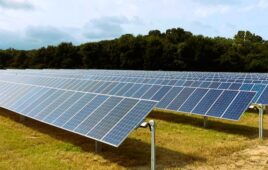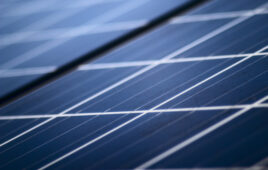An innovative dual-output off-grid inverter allows the flexibility to run different types of AC loads with or without batteries.
By Dr. George S. Cheng, CTO, CyboEnergy
With the rapid deployment of renewable energy, some areas of the grid can no longer accommodate additional solar. Hawaii ended its solar net-metering program in 2015 and its utilities have imposed restrictions to avoid solar loads on the grid. In April, California’s ISO forced the temporary shutdown of some large solar farms to avoid grid instability. Off-grid solar is increasingly becoming a good option for these kinds of markets—especially for heating and cooling.
Heating, cooling, and refrigeration are essential in daily life. We often do not realize they add up to 50% of the energy consumed in our households. Using off-grid solar to provide energy for these aspects can offset much of a home’s energy cost.
Basics off-grid system design
A traditional off-grid solar power system, as shown in Figure 1, includes multiple solar panels connected in series and/or in parallel to feed DC power to a solar charge controller, which then charges a battery. An inverter takes DC power from the battery and supplies AC power to the load. The battery is the central piece of this system and is always at work even when the sun is shining. It has to be large enough to supply sufficient power for the load day and night. This causes ongoing wear and tear that stresses the battery’s life.

Figure 1. Traditional off-grid solar system
Storing solar energy without batteries
Rather than storing energy in batteries, another option is to store solar energy in the form of hot water. Figure 2 shows a 1.2-kW off-grid solar inverter connected to the lower heating element of a water heater, delivering solar energy directly from the solar panels to heat the water. This type of system design doesn’t require a battery. The temperature for the lower heating element can be set much higher than the upper element. This prevents the upper element, which consumes grid power, from turning on unless a large amount of hot water is used within a short time. Hot water will always be available because grid power can heat the water quickly from the upper heating element.

Figure 2. Off-grid PV solar water heating
Additionally, the unique design of the CyboInverter shown in the figure allows it to directly connect to four 250- to 320-W solar panels, while traditional microinverters may only attach to one. Therefore, a single 1.2-kW CyboInverter can supply sufficient hot water for a two-person family. Likewise, two daisy-chained CyboInverters can attach to eight panels and supply enough hot water for four to five people.
This is a simple way to store solar energy in the form of hot water without using batteries. It reduces electric bills while also solving grid instability issues. This design is also more cost-effective than installing solar thermal solutions on the roof because it eliminates moving parts and is suitable for cold climates where the water in collectors may freeze.
One inverter for both heating and refrigeration
Since a heating element is a resistive load and a cooling compressor requires a lot of surge power to start, it is very difficult for an off-grid inverter to run both types of loads effectively and efficiently. Figure 3 shows a dual-output off-grid inverter that can supply AC power through either off-grid output port 1 or port 2 to run heating or cooling devices respectively.

Figure 3. A dual-output off-grid CyboInverter
An off-grid solar power system for heating and refrigeration illustrated in Figure 4 has two dual-output off-grid solar power inverters, where a master unit is daisy-chained with a slave unit to form a 2.4-kW system. Four 300-W solar panels connect to four input channels of the two inverters. One 48-V battery connects to the remaining four input channels in parallel to provide enough surge power to start the compressor of an air conditioner or refrigerator. The battery can also provide nighttime power for the system. Automatic, manual or remotely controllable IoT-based switches can be added to the system to switch between the two off-grid modes.

Figure 4. An off-grid solar system for heating and refrigeration
In the first off-grid mode, the system can harvest energy from the solar panels and send power through output port 1 (left side) of the inverter to a single-element or dual-element electric water heater or area heater. The wattage of the solar power does not have to match the wattage of the total loads because the inverters are not trying to regulate the output voltage. In this case, the off-grid inverters will always work, with MPPT enabled for each solar panel for maximum energy harvest. The connected batteries are typically idle because there is no need to send battery power to an electric water heater.
In the second off-grid mode, the system can power lights, fans, PC, phone chargers and a refrigerator through the inverter’s output port 2 (right side). In this mode, the 48-V battery plays an important role because it provides needed DC power for the inverters to generate surge power to start the compressor of the refrigerator. After the refrigerator is started, the required AC power will drop significantly. If the solar provides sufficient power to allow the inverters to run the refrigerator, the inverters will not pull power from the battery. This ensures a longer battery life. The system can also run new types of air conditioners that require much less surge power than traditional air conditioning units.
Compared with traditional off-grid solar systems, the described dual-output off-grid solar power system has many features and benefits including:
- Does not require batteries for normal operations,
- Dual AC outputs to enable off-grid heating, cooling, and refrigeration,
- Panel level MPPT to maximize solar power production,
- No high voltage or high current DC so the system is intrinsically safe,
- Flexible to build larger microgrids with multiple inverters,
- Cost-effective, and easy to install and maintain.




Just the product I am looking for! I have 7 old panels I took off to make room for 12 new panels and I was looking at what to do with the old panels. Also since we are limited to a maximum 10kw solar system and still get a feed-in tariff here in NSW Australia I cannot grid-connect the old 7 panels. So this off-grid water heater is perfect. However, I will be creating a larger insulated water tank to store the heat energy and use heat transfer tubing to pre-heat the water going into my gas water heater tank to reduce my gas bill.
I was going to rig up the panels to a low voltage water heating element via a thermostat but the MPPT function of the Cyboinverter will make it more efficient plus I don’t need to experiment and develop a new system. Just the plug and play system I’m looking for.
We own a small retail shop consisting of 3 rooms (12′ x 24′), 10′ x 16′, and 10′ x 12′. All three are connected and there are no doors. Would like to go totally solar for heat and air, with no connection to the power company. Is there a small unit that would work for us at a reasonable price?
These units run about $750. And I would buy one or more. Smart thinking to mr Chang .
Doesn’t make sense to me. Says it’s off grid but shows hook up to grid AC.
The grid power is supplied just to the top element in the water heater as a backup to the solar on a need be basis. If the top element temperature drops sufficiently due to large amounts of water being used the second (top) element turns on and assist the solar powered lower element.
It would be great if they had a larger unit. With panel costs dropping, and batteries still expensive, using the panels for heating\cooling seems promising. However, heating and cooling still requires a lot of power and thus a lot of panels.
Is it not true that all inverters are the same? Don’t they simply just convert DC to AC thus this concept could be used for all Inverters? What makes this different from others?
This article is a total SHILL